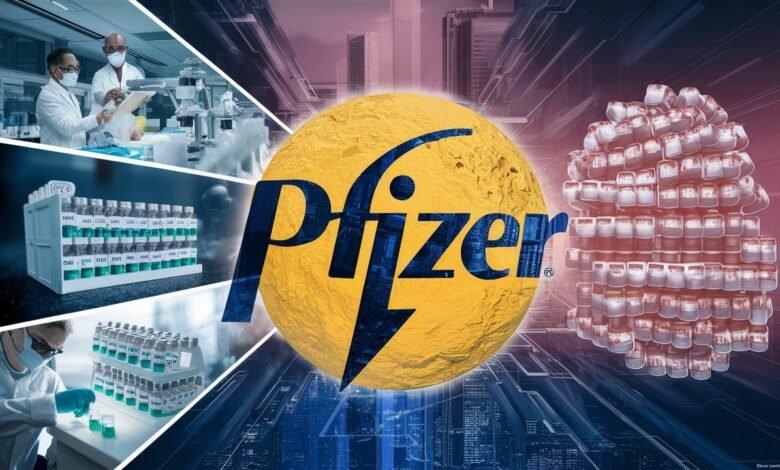Pfizer Inc. (PFE): A Legacy of Innovation Navigates Post-Pandemic Transformation

Company Overview: A Pharmaceutical Titan
Founded in 1849 by cousins Charles Pfizer and Charles Erhart in Brooklyn, New York, Pfizer has evolved from a small chemical producer to a global biopharmaceutical powerhouse. Today, the company employs approximately 81,000 people and boasts a market capitalization of $139.5 billion (as of June 13, 2025) 12. Its product portfolio spans vaccines, oncology, cardiology, immunology, and rare diseases, with blockbusters including Eliquis (cardiovascular), Prevnar (pneumococcal vaccine), Ibrance (oncology), and Comirnaty (COVID-19 vaccine). Pfizer’s operational footprint encompasses over 125 countries, with nearly 50% of revenue generated internationally 19.
The company’s recent leadership under CEO Dr. Albert Bourla has emphasized strategic pivots toward oncology and cost realignment. In 2024, Pfizer celebrated its 175th anniversary, highlighting a legacy of scientific breakthroughs—from mass-producing penicillin during WWII to developing the first FDA-authorized COVID-19 vaccine 24.
Financial Performance: Resilience Amid Transition
Pfizer reported $63.6 billion in 2024 revenue, marking 7% year-over-year operational growth. Excluding COVID-19 products, growth accelerated to 12%, reflecting robust demand for non-pandemic therapeutics like Eliquis ($7.4B revenue) and Vyndaqel ($5.5B) 4. Despite this progress, net income faced pressure due to post-pandemic revenue normalization:
- Reported Net Income: $8.0B (2024) vs. $31.4B (2022)
- Adjusted Diluted EPS: $3.11 (2024), up 69% from 2023 4
Table: Key Financial Metrics (2022–2024)
| Metric | 2024 | 2023 | 2022 |
| Revenue | $63.63B | $59.55B | $101.18B |
| Reported Net Income | $8.03B | $2.12B | $31.37B |
| Adjusted Diluted EPS | $3.11 | $1.84 | $6.58 |
| R&D Investment | $10.8B | $12.6B* | $11.4B* |
| Dividend Payments | $9.5B | $9.2B | $9.0B |
Cost Efficiency: A $4.5 billion cost-realignment program (slated for completion by end-2025) aims to offset revenue declines. Meanwhile, Pfizer reduced debt by $7.8 billion in 2024, strengthening its balance sheet 4.
Therapeutic Areas & Pipeline: Beyond COVID-19
Pfizer’s “five strategic priorities” for 2024–2025 center on achieving oncology leadership and delivering the next innovation wave. Recent successes include:
- Oncology: Padcev (bladder cancer) and Adcetris (lymphoma) contributed to a 12% operational revenue surge in non-COVID products. The acquisition of Seagen bolstered Pfizer’s antibody-drug conjugate capabilities 4.
- Vaccines: RSV vaccine Abrysvo and pediatric pneumococcal vaccines drove growth, with 1 billion doses of Prevnar delivered to lower-income countries via Gavi 4.
- Rare Diseases: Vyndaqel (transthyretin amyloidosis) generated $5.5B, becoming Pfizer’s fourth-largest product 4.
In 2024, Pfizer secured 14 FDA/EMA approvals, including treatments for hemophilia and cervical cancer. The pipeline features 64 late-stage programs, with mRNA technology (pioneered during COVID-19) being repurposed for influenza and shingles vaccines 49.
Market Dynamics & Challenges
Post-Pandemic Headwinds
COVID-19 product revenues (Comirnaty and Paxlovid) plummeted from $56.7B (2022) to $11.1B (2024), creating a $45B revenue gap. Management expects stabilization by 2026 but faces investor skepticism 49.
Political & Pricing Pressures
A May 2025 executive order by former President Trump threatens enforced drug price cuts if voluntary industry negotiations fail. Analysts warn this could pressure margins, particularly for Medicare-dependent products like Eliquis 89.
Competition & Patent Cliffs
Key drugs (e.g., Ibrance) face patent expirations starting in 2027. Biosimilar competition for Xeljanz and legacy products further complicates growth 311.
Investment Thesis: Dividend Powerhouse in Transition
Compelling Dividend Profile
- Dividend Yield: 7.01% ($1.72 annual dividend) 15
- Payout Ratio: 55% (based on 2024 adjusted EPS), down from 119% in 2024, signaling improved sustainability 49
Valuation Metrics
Pfizer trades at a forward P/E of 8.4x (vs. industry average 15x), suggesting undervaluation 111:
- Price/Sales: 2.24x
- Price/Book: 1.54x
- Debt/Equity: 68.8% (down from 80% in 2023) 19
Table: Analyst Price Targets & Sentiment
| Analyst Firm | Rating | Price Target | Implied Upside | |
| Truist Securities | Buy | $32 | 30% | |
| Cantor Fitzgerald | Neutral | $24 | -2% | |
| Jefferies | Buy | $34 | 39% | |
| Consensus (24 Analysts) | Hold | $29.24 | 19% | 11 |
Growth Catalysts
- Oncology Pipeline: New cancer therapies (e.g., Elrexfio for myeloma) could generate $5B+ annually by 2030 4.
- Cost Savings: $4.5B net savings from layoffs and manufacturing optimization 4.
- Capital Allocation: Debt reduction and share buybacks may boost EPS once deleveraging concludes 4.
Conclusion: Balancing Legacy with Innovation
Pfizer stands at a crossroads: its 175-year legacy of scientific breakthroughs collides with post-pandemic realities and political uncertainty. While COVID windfalls have faded, foundational strengths—a diversified portfolio, deep R&D capabilities, and shareholder-friendly dividends—endure. For investors, Pfizer offers high yield with moderate growth potential, suited for income-focused portfolios. Success hinges on executing its oncology pivot and navigating U.S. drug pricing reforms. As Bourla stated, “Aiming high is embedded in our DNA” 4—a ethos that must now translate to sustainable value beyond the pandemic era.
Frequently Asked Questions (FAQs)
Q1: Is Pfizer’s 7% dividend yield sustainable?
Yes, based on 2024’s 55% adjusted EPS payout ratio and debt reduction. However, significant pipeline setbacks or pricing pressures could necessitate reevaluation 149.
Q2: How is Pfizer replacing lost COVID-19 revenue?
Through oncology expansion (Padcev, Adcetris), vaccine diversification (RSV, pneumococcal), and cost cuts ($4.5B savings program). Non-COVID revenue grew 12% in 2024 411.
Q3: What is Pfizer’s exposure to U.S. drug pricing reforms?
High. Medicare-reliant drugs (Eliquis, Prevnar) contribute 30%+ of revenue. Trump’s 2025 executive order threatens forced discounts if voluntary negotiations fail 89.
Q4: What are key upcoming catalysts for the stock?
- Q2 2025 Earnings (Jul 28–Aug 1): Focus on cost savings progress.
- Oncology Data Readouts: Updates for Elrexfio and vepdegestrant.
- Debt Reduction Completion: Expected by late 2025, potentially enabling buybacks 411.
Q5: How does Pfizer support global health equity?
Initiatives include “Accord for a Healthier World” (providing patented drugs at cost to 45 lower-income nations) and drone-delivery partnerships with Zipline in Africa 4.



